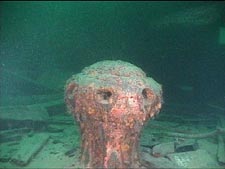Wreck of the Vienna: Blow-off Dive or Great Wreck Dive?
Wreck of the Vienna: Blow-off Dive or Great Wreck Dive?
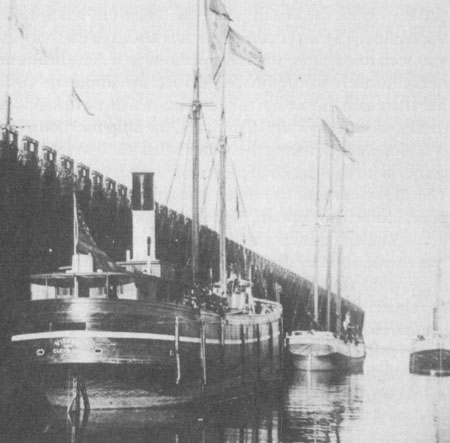
The Vienna
Whitefish Point, in the northern Michigan Peninsula, offers some of
the finest diving anywhere in the Great Lakes. Take all the best
features of all your usual Great Lakes dive destinations, put them
all together, and you have Whitefish Point.
Whitefish Point has historic wrecks similar to the Kingston area, clarity similar to the St. Lawrence/Brockville area and services similar to Tobermory. The area around Whitefish Point boasts a wide range of shipwrecks, from wooden steamers to large steel freighters. Unfortunately, nearly all of the diving here is deep, which increases hang time in the colder Lake Superior waters. The Vienna represents a shallow alternative, much closer to shore, that can be undertaken with shorter decompression times than some of her deeper siblings.
Extended range divers use the Vienna as a blow-off dive, because it is shallow and very close to shore. However, the Vienna also represents one of the finest wrecks to dive in Michigan’s Upper Peninsula.
The Vienna is one of a number of similar ships lost in Lake Superior during the late 1800s. She is a wooden steamer that also had sail rigging. When steam power was first introduced, its reliability had to be demonstrated to insurance companies. To maintain insurance coverage, ships of this time period were required to also carry sails. These types of wrecks are fascinating to explore since they include not only remnants of sail rigging, like deadeyes, but also early design boilers and engines.
The Vienna came to her demise the same way that many do in Lake Superior, by collision. On 16 September 1892, she was down bound from Marquette, Michigan, with a load of iron ore. In tow was the schooner Mattie C. Bell. At Whitefish Point, the Vienna met up with the Nipigon. The Nipigon also had schooners in tow. Without warning, the Nipigon suddenly veered and struck the Vienna. Despite the efforts of both crews to save the Vienna, the vessel sank approximately one mile from shore. It was never fully understood why the Nipigon veered off course.
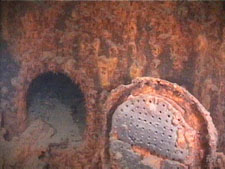 Boiler T. Irvine/J.Post |
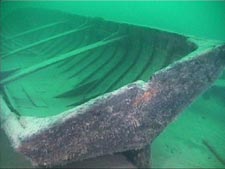 Lifeboat T. Irvine/J.Post |
Despite being close to shore, the Vienna lies in approximately 140 feet of water. It is the shallowest of all the dives in the Whitefish Point area, making it a back-up dive location for extended range divers.
The descent line runs to the stern area. The wreck is very much intact with only the upper cabins conspicuously absent. Some implements and a clay pot sit on the decking. Moving forward on the top deck, one notices the huge boiler and the large engine components rising up from the bowels of the wreck. Peering down through the space left for the engine, one can get a glimpse of the two decks below the main deck. Today, we would immediately descend to the bottom and work our way back along the deck prior to ascending.
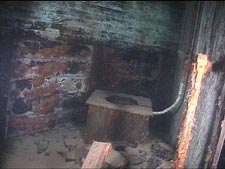 Head T. Irvine/J.Post |
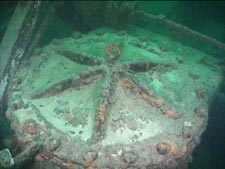 Engine T. Irvine/J.Post |
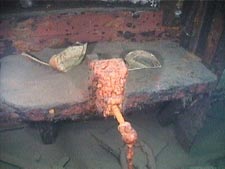 Vise T. Irvine/J.Post |
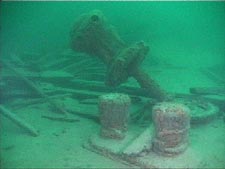 Bow T. Irvine/J.Post |
The Vienna was loaded with iron ore when she went down; this was
quite apparent as we moved along the hold section of the wreck.
Large deposits made negotiating the bottom section a little
trickier, but there was still ample room to allow a dive team to
make their way forward. Every now and then, shafts of green would
remind us that open water was never that far away. The huge
coalbunkers, still filled with coal, were visible as we swam
forward. As with nearly all Great Lakes shipwrecks, 'ling cod' were
everywhere and seemed annoyed that their peaceful domain had again
been interrupted.
 Shovel T. Irvine/J.Post |
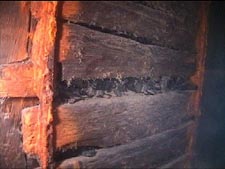 Coal bunker T. Irvine/J.Post |
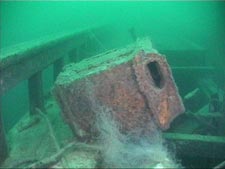 Stove T. Irvine/J.Post |
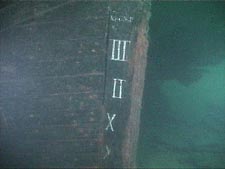 Draft T. Irvine/J.Post |
|
|
As we came close to the bow of the wreck, we were able to observe the hanging knees used to support the upper decks. We slowly ascended to the next level. Here, we could observe more items related to the Vienna’s sail rigging requirements. Deadeyes, bits of line, and other items, stood out in sharp contrast to the stern. Here a light was hardly required, since steady streams of light penetrated the dense wood and provided intermittent glimpses of the ship's craftsmanship.
The tour concluded as we made our way along the top deck. The shipwreck seemed to transcend maritime history. The bow provided a historical review of the sail era with masts, complete with rigging, fallen along the deck. A huge lifeboat still rests on the decking as if waiting to be put to service. Capstan and davits showed some damage as a result of the sinking.
The stern provided a view of what was then new and upcoming technology, with the huge engines and boiler. One area still had a workbench complete with vice and implements. The stern capstan appeared largely undamaged.
In its own right, the wreck of the Vienna is a great dive. In some ways it is unfortunate that it is bypassed by many divers in search of the more spectacular wrecks located off Whitefish Point. The Vienna represents an interesting period of Great Lakes maritime history.
REFERENCES:
Wolff J.F. Jr. “Lake Superior Shipwrecks.” Lake Superior Port Cities Inc. P.O. Box 16417, Duluth, Minnesota 55816-0417. Pp 67.
Copyright ©2003 Global
Underwater Explorers.
All rights reserved.

